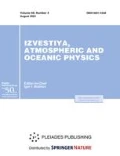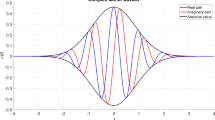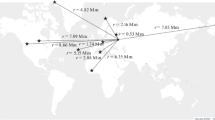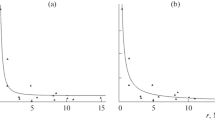Abstract
Atmospheric infrasonic signals were classified on the basis of data obtained in the United States (University of Alaska, Fairbanks) and in the Antarctic region (Windless Bight) from 1980 to 1983. The data archive included five classes of signals from different sources: explosions, mountain associated waves, microbaroms, volcanic infrasound, and auroral infrasonic waves. This classification was based on the theory of testing statistical hypotheses. The possibilities of separating these classes were studied. It was shown that the signals (from the archive used) that are characteristic of explosions and volcanic activity can be rather easily separated from those characteristic of mountain associated waves, microbaroms, and auroral infrasonic waves.
Similar content being viewed by others
References
P. Grenard, “Status of the IMS Infrasound Network,” in Proceedings of the Infrasound Technology Workshop, October 18–22, 2010, Tunis, Tunisia.
S. N. Kulichkov, G. A. Bush, A. I. Svertilov, “New Type of Infrasonic Arrivals in the Geometric Shadow Region at Long Distances from Explosions,” Izv., Atmos. Ocean. Phys. 38(4), 397–402 (2002).
N. D. Tsybulskaya, S. N. Kulichkov, and A. I. Chulichkov, “Analysis of Classification Possibility Infrasound Signals from Different Sources Based on Correlation Ability,” in Proceedings of the International Conference “Comprehensive Nuclear-Test Ban Treaty: Science and Technology, June 8–10, 2011, Vienna, Austria.
E. L. Lehman, Testing Statistical Hypotheses (Wiley, New York, 1959; Nauka, Moscow, 1979).
Library of Typical Infrasonic Signals, Matlab Files of Infrasonic Sensor Data with Online Analysis Parameters for Each 2.5 min of Data (Geophysical Institute, University of Alaska, 2007).
Yu. P. Pyt’ev and A. I. Chulichkov, Methods of Morphological Image Analysis (Fizmatlit, Moscow, 2010) [in Russian].
S. N. Kulichkov, A. I. Chulichkov, and D. S. Demin, Morphological Analysis Infrasonic Signals in Acoustics (Novyi Akropol’, Moscow, 2010) [in Russian].
N. E. Golyandina, The Caterpillar-SSA Method: Time Series Analysis (St. Petersburg State University, St. Petersburg, 2004) [in Russian].
Yu. P. Pyt’ev, Matematical Modeling Methods for Measuring and Computing Systems (Fizmatlit, Moscow, 2004) [in Russian].
Author information
Authors and Affiliations
Corresponding author
Additional information
Original Russian Text © N.D. Tsybul’skaya, S.N. Kulichkov, A.I. Chulichkov, 2012, published in Izvestiya AN. Fizika Atmosfery i Okeana, 2012, Vol. 48, No. 4, pp. 434–441.
Rights and permissions
About this article
Cite this article
Tsybul’skaya, N.D., Kulichkov, S.N. & Chulichkov, A.I. Studying possibilities for the classification of infrasonic signals from different sources. Izv. Atmos. Ocean. Phys. 48, 384–390 (2012). https://doi.org/10.1134/S0001433812040147
Received:
Published:
Issue Date:
DOI: https://doi.org/10.1134/S0001433812040147




